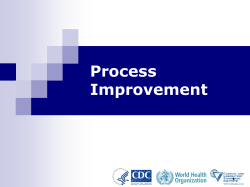
YD_Congress_Justice Indicators_Doha_April 15_2015
Justice Indicators in Support of Criminal Law Reform Yvon Dandurand 13th United Nations Congress on Crime Prevention and Criminal Justice, Doha, Qatar, April 15, 2015 ICCLR/TIJ Ancillary Meeting – Justice Indicators Thank you for joining us today Purpose of this “Ancillary Meeting” Successful Justice Reforms Require A clear vision of the goals and objectives to be achieved collectively and by each component of the justice system Explicit and measureable performance targets and expected timeframes Collection and analysis of relevant data Use of justice performance indicators Measuring is a Key Element of Justice Reform Justice indicators are useful tools to evaluate performance, draw attention to issues, establish benchmarks, monitor progress, and evaluate the impact of interventions or reform initiatives. Good Performance Measurement Framework Multidimensional (capture complexity) Value-based Limited number of specific performance measures (perhaps with targets/benchmarks) Measures which are not controversial and represent in clear terms what the system is intended to deliver Offer sensible feedback to managers and policy makers Make sense to the public Indicators are measured regularly and consistently over time to capture change Indicators are developed and measured independently Measuring the Achievement of Strategic Goals of Proposed Reforms What are the strategic goals behind the proposed reforms and how do they relate to performance? What are the expected outcomes and how will they be measured? What is the normative framework (e.g., international standards and norms) The importance of the dialogue JUSTICE OUTCOMES INDICATORS Examples Access to justice – social equity – regional accessibility – equal access Compliance with standards or targets Public confidence – Public trust & respect Public safety – Public order- Fear of crime Crime reduction Responsiveness to change Offender accountability, reintegration, prevention of recidivism RESISTANCE Performance measurement is still a somewhat “alien concept” in the justice sector. Why is there so much resistance to the idea that we should measure the outcomes of the justice system? Everyone seems to want to be measured on “effort” not on “results”. Developing indicators can help create a culture of accountability and transparency – that is sometimes perhaps the most important benefit. The World Justice Project Cross-country comparisons have been made by assessing justice institutions against the Rule of Law Index, as part of the World Justice Project Measures the performance of justice systems on the basis of some of the outcomes that the rule of law brings to societies – such as accountability, respect for fundamental rights, or access to justice. The Rule of Law Index seeks to measure the extent to which these outcomes are achieved by means of comprehensive set of performance indicators. For post-conflict situations 135 indicators Focused on criminal justice Four Main dimensions (Performance; Capacity; Treatment of vulnerable groups; integrity, transparency and accountability Five sources of data Police Judiciary (judges, prosecutors and defence) Prisons Expert survey (78 indicators) Public survey (24 indicators) Administrative data (17) Document review (16) Field data Focused on measuring change over time The United Nations Rule of Law Indicators http://www.un.org /en/peacekeeping/ publications/un_rul e_of_law_indicator s.pdf Structure of the Instrument 25 baskets Security, safety and order Performance Prisoner health, welfare and rehabilitation Integrity Prisons Public confidence Performance Access to justice Effectiveness and efficiency Judiciary Integrity, acountability and transparency Treatment of vulnerable groups Capacity Integrity and independence Transparency and accountability Material resources Human resources Administrative and management capacity Integrity, transparency and accountability Treatment of vulnerable groups Capacity Transparency and accountability Material resources Human resources Administrative and management capacity The Post-2015 Development Goals The UNODC Report (Accounting for Security and Justice in the Post-2015) Development Agenda: Linking security, justice, and development Need for a measurement framework for justice and security in relation to development How will countries approach the development of justice indicators? How can this process be supported? Justice Indicators and Criminal Justice Reform – A Reference Tool Thank you Yvon.Dandurand@ufv.ca
© Copyright 2025


















